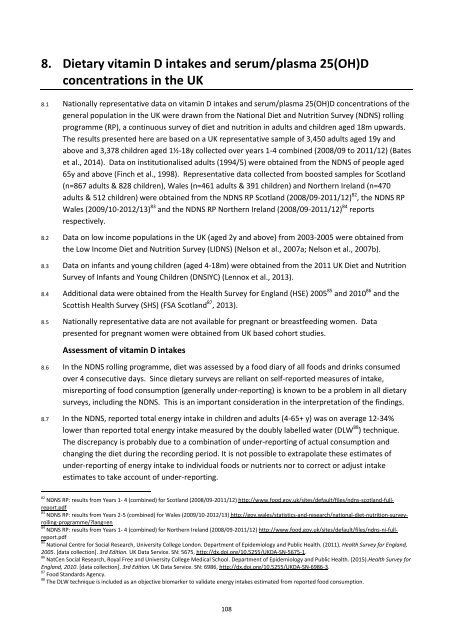Vitamin D and Health
SACN_Vitamin_D_and_Health_report
SACN_Vitamin_D_and_Health_report
You also want an ePaper? Increase the reach of your titles
YUMPU automatically turns print PDFs into web optimized ePapers that Google loves.
8. Dietary vitamin D intakes <strong>and</strong> serum/plasma 25(OH)D<br />
concentrations in the UK<br />
8.1 Nationally representative data on vitamin D intakes <strong>and</strong> serum/plasma 25(OH)D concentrations of the<br />
general population in the UK were drawn from the National Diet <strong>and</strong> Nutrition Survey (NDNS) rolling<br />
programme (RP), a continuous survey of diet <strong>and</strong> nutrition in adults <strong>and</strong> children aged 18m upwards.<br />
The results presented here are based on a UK representative sample of 3,450 adults aged 19y <strong>and</strong><br />
above <strong>and</strong> 3,378 children aged 1½-18y collected over years 1-4 combined (2008/09 to 2011/12) (Bates<br />
et al., 2014). Data on institutionalised adults (1994/5) were obtained from the NDNS of people aged<br />
65y <strong>and</strong> above (Finch et al., 1998). Representative data collected from boosted samples for Scotl<strong>and</strong><br />
(n=867 adults & 828 children), Wales (n=461 adults & 391 children) <strong>and</strong> Northern Irel<strong>and</strong> (n=470<br />
adults & 512 children) were obtained from the NDNS RP Scotl<strong>and</strong> (2008/09-2011/12) 82 , the NDNS RP<br />
Wales (2009/10-2012/13) 83 <strong>and</strong> the NDNS RP Northern Irel<strong>and</strong> (2008/09-2011/12) 84 reports<br />
respectively.<br />
8.2 Data on low income populations in the UK (aged 2y <strong>and</strong> above) from 2003-2005 were obtained from<br />
the Low Income Diet <strong>and</strong> Nutrition Survey (LIDNS) (Nelson et al., 2007a; Nelson et al., 2007b).<br />
8.3 Data on infants <strong>and</strong> young children (aged 4-18m) were obtained from the 2011 UK Diet <strong>and</strong> Nutrition<br />
Survey of Infants <strong>and</strong> Young Children (DNSIYC) (Lennox et al., 2013).<br />
8.4 Additional data were obtained from the <strong>Health</strong> Survey for Engl<strong>and</strong> (HSE) 2005 85 <strong>and</strong> 2010 86 <strong>and</strong> the<br />
Scottish <strong>Health</strong> Survey (SHS) (FSA Scotl<strong>and</strong> 87 , 2013).<br />
8.5 Nationally representative data are not available for pregnant or breastfeeding women. Data<br />
presented for pregnant women were obtained from UK based cohort studies.<br />
Assessment of vitamin D intakes<br />
8.6 In the NDNS rolling programme, diet was assessed by a food diary of all foods <strong>and</strong> drinks consumed<br />
over 4 consecutive days. Since dietary surveys are reliant on self-reported measures of intake,<br />
misreporting of food consumption (generally under-reporting) is known to be a problem in all dietary<br />
surveys, including the NDNS. This is an important consideration in the interpretation of the findings.<br />
8.7 In the NDNS, reported total energy intake in children <strong>and</strong> adults (4-65+ y) was on average 12-34%<br />
lower than reported total energy intake measured by the doubly labelled water (DLW 88 ) technique.<br />
The discrepancy is probably due to a combination of under-reporting of actual consumption <strong>and</strong><br />
changing the diet during the recording period. It is not possible to extrapolate these estimates of<br />
under-reporting of energy intake to individual foods or nutrients nor to correct or adjust intake<br />
estimates to take account of under-reporting.<br />
82 NDNS RP: results from Years 1- 4 (combined) for Scotl<strong>and</strong> (2008/09-2011/12) http://www.food.gov.uk/sites/default/files/ndns-scotl<strong>and</strong>-fullreport.pdf<br />
83 NDNS RP: results from Years 2-5 (combined) for Wales (2009/10-2012/13) http://gov.wales/statistics-<strong>and</strong>-research/national-diet-nutrition-surveyrolling-programme/?lang=en<br />
84 NDNS RP: results from Years 1- 4 (combined) for Northern Irel<strong>and</strong> (2008/09-2011/12) http://www.food.gov.uk/sites/default/files/ndns-ni-fullreport.pdf<br />
85 National Centre for Social Research, University College London. Department of Epidemiology <strong>and</strong> Public <strong>Health</strong>. (2011). <strong>Health</strong> Survey for Engl<strong>and</strong>,<br />
2005. [data collection]. 3rd Edition. UK Data Service. SN: 5675, http://dx.doi.org/10.5255/UKDA-SN-5675-1.<br />
86 NatCen Social Research, Royal Free <strong>and</strong> University College Medical School. Department of Epidemiology <strong>and</strong> Public <strong>Health</strong>. (2015).<strong>Health</strong> Survey for<br />
Engl<strong>and</strong>, 2010. [data collection]. 3rd Edition. UK Data Service. SN: 6986, http://dx.doi.org/10.5255/UKDA-SN-6986-3.<br />
87 Food St<strong>and</strong>ards Agency.<br />
88 The DLW technique is included as an objective biomarker to validate energy intakes estimated from reported food consumption.<br />
108


